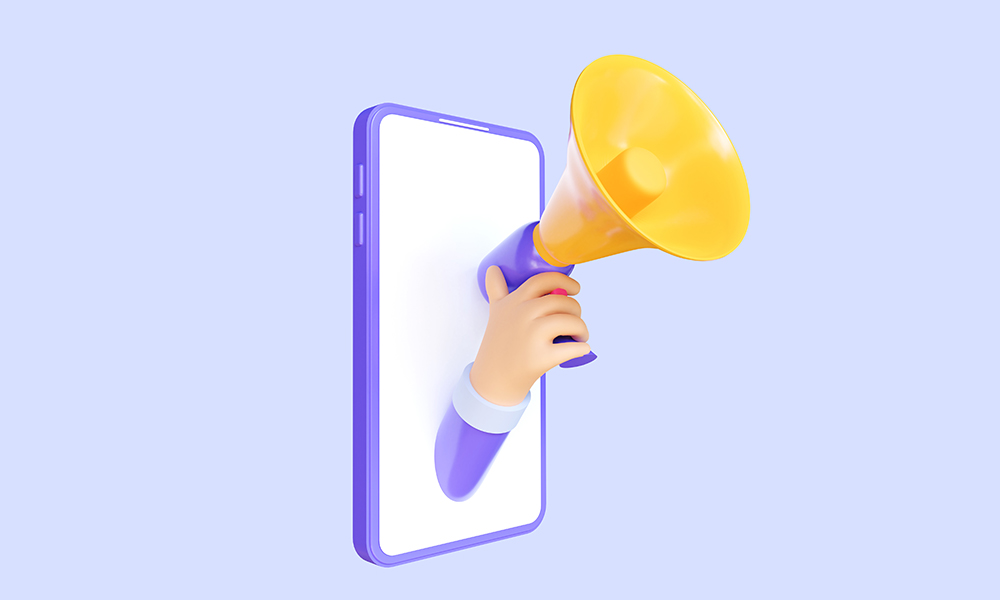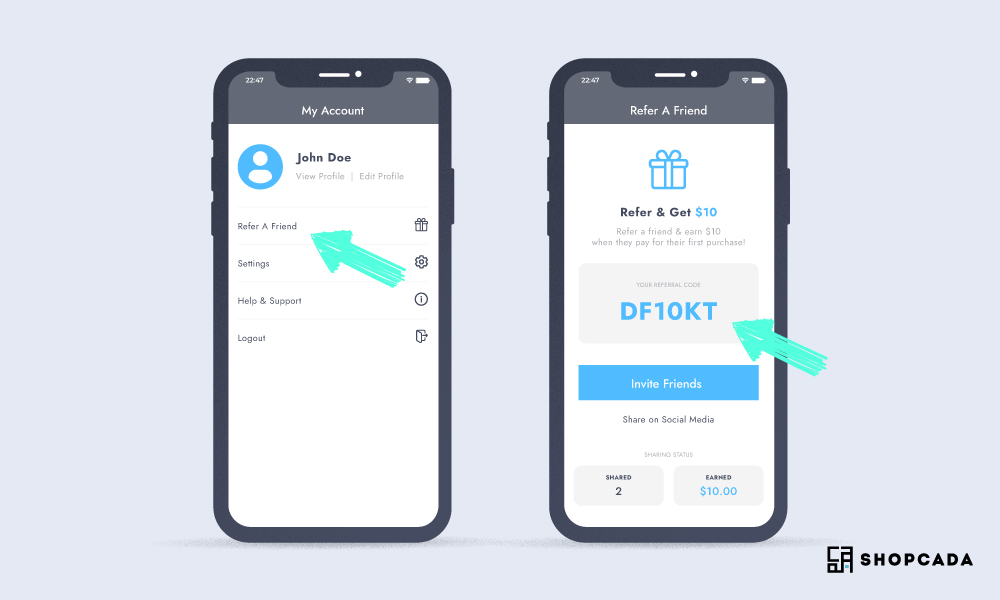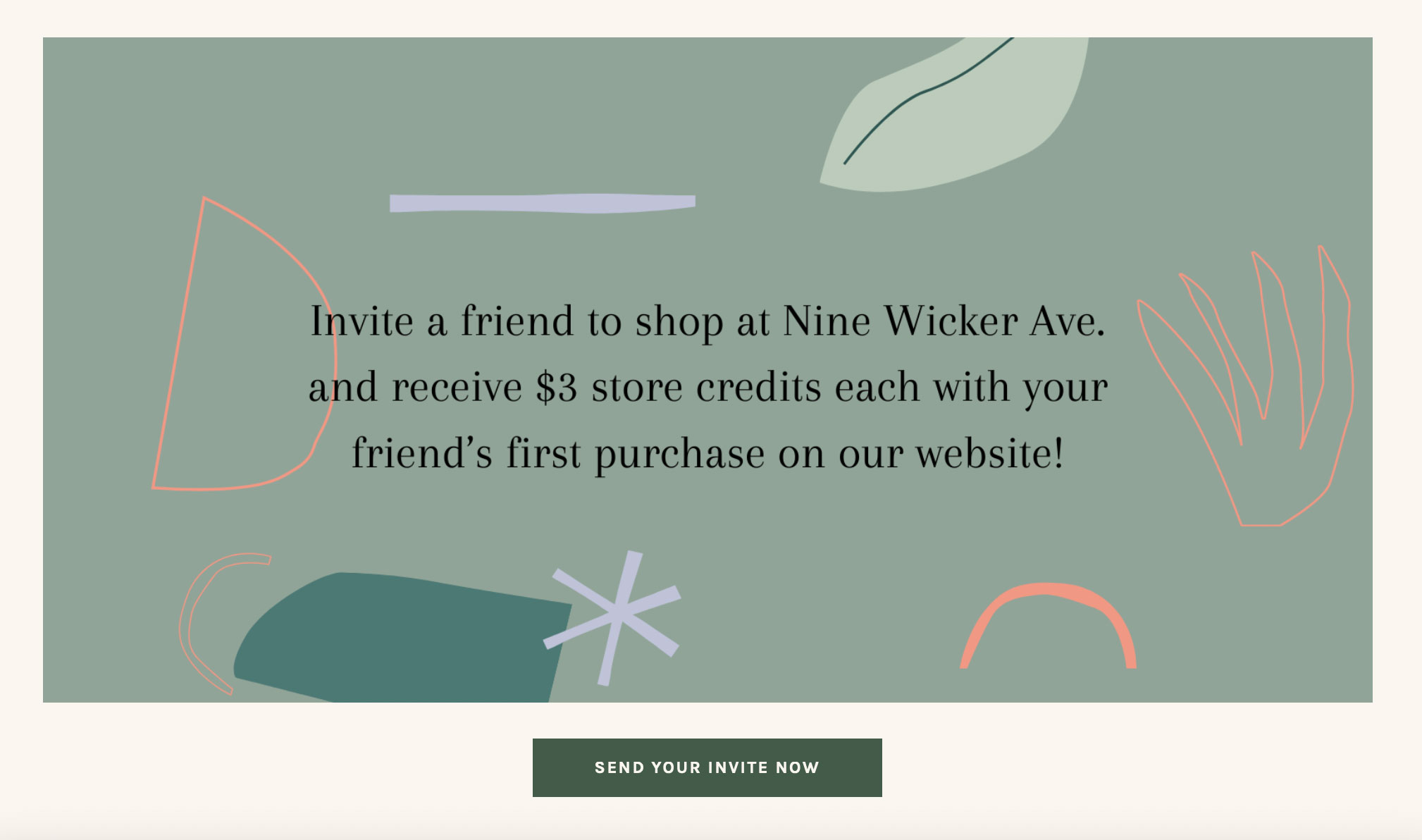100% Beginner Overview: Ecommerce Referral Programs

Word-of-mouth marketing is frequently referred to as the holy grail of growth because it scales as you add more happy customers and converts like crazy.
But many marketers fail to realize that this doesn't always occur naturally.
You may nudge content customers to spread the word and advertise your goods through a referral scheme. In this approach, word-of-mouth marketing offers all its advantages at a fraction of the price of other paid acquisition channels like advertisements.
But how can you design a scalable and affordable e-commerce referral program for your clients that will fuel growth? We’ll go through the following with you:
-
A referral program
-
The power of referral marketing
-
Things to take into account while establishing a referral program
-
Important actions to take while developing a successful referral program
-
Examples of effective referral schemes
-
Avoid common referral program errors
And some other bonus topics.
Nice, huh? Let's get going.
What Is A Referral Program?

A referral program is a system that incentivizes your current consumers to recommend your product to their contacts in return for incentives.
Free goods, bonuses, store credits, or even cash could be offered as these rewards. The business is solely responsible for determining the precise structure.
While they have relatively modest client acquisition expenses, referral programs have established themselves as the cornerstone of many e-commerce businesses. It's a low-risk method for a chance at viral development, especially because you're just required to pay for performance.
Since every customer that is referred has the potential to refer one, two, three, or even more customers, the correct product and incentives can result in a network effect that essentially scales on its own.
Behold, Referral Marketing!
92% of individuals believe the advice of their friends and acquaintances, according to a Nielsen study. The same rationale underlies the importance of customer endorsements, social proof, ratings, and product reviews in helping buyers move forward in the purchasing process.
People are trusted, to put it briefly. Additionally, as an online store with a referral program, you can take advantage of human nature and convert your most loyal customers into brand ambassadors.
Although it might appear difficult to set up, even straightforward referral systems can have a significant impact. Some of the essential qualities that make referral marketing so effective are listed below:
Ease to launch. To benefit from a referral program, you don't need an intricate rewards system. The foundation of any effective program is valuable rewards that are also doable.
Low-cost. Advertising is pricey. Social networking is not always successful. Referral marketing, however, merely entails your clients promoting you to others. Finding a successful incentive structure is simple if you are aware of the lifetime value (LTV) of your clients.
The operational differences between managing a referral program with 20, 200, or 2,000 monthly referrals can be minimised with a little automation.
With referral marketing, everything can be tracked using the platform you choose for your referral program. KPIs such as impressions, clicks, sales, commissions, and more are all accessible through the dashboard for your program.
Additional advantages. Referral marketing also aids in PR and brand mentions and delivers social evidence, client loyalty and trust, brand legitimacy, and brand awareness.
A referral program can assist you in scaling growth in a way that generates clients well beyond what you can directly attribute to the channel, which is important because brand recognition is a key element in many purchasing decisions.

Things To Keep In Mind
Referral programs should not be intricate, but they must be worthwhile to your customers. Everyone knows that they won't recommend friends for a reward that they don't genuinely want or isn't worth their time.
Here are some things to think about while building up your referral program to make sure it is aggressive, alluring, and successful.
Research!
Make a list of your e-commerce rivals and investigate their referral programs to get started. What kinds of rewards are being provided? What level of performance is necessary to receive each incentive, too?
The presence of your competitor's referral links on blogs, social media, media outlets, and forums, for instance, is a good indication that the $25 per referral offered by your competitor is a sufficient incentive for individuals to take action.
However, you need to strike a balance. If the reward is too great, people may advertise your product dishonestly or in a way that is inconsistent with your brand in exchange for a large compensation. If it's too low, your consumers might not feel appreciated or like their time and effort are worthwhile.
A good place to start is by examining the elements that make your competitors' referral programs successful.
Know Thy Customers!
By conducting surveys, looking at recent support requests, or even just reading online product reviews, you can examine your customers' demands.
An NPS survey is one of the most used approaches to measure customer happiness. More consumer feedback from these surveys can help you improve your goods and onboarding processes for new customers.
Customers are asked to score your product on a scale of 1 to 10 and to state if they would suggest it to a friend. You'll get more adept at fine-tuning your products and customer onboarding the more frequently your customers participate in surveys.
Your net promoter score, or NPS, is the average value. With the correct incentives, a high NPS can be a sign that your referral program has the potential to be very successful.
And the better you understand your customer's needs, the simpler it will be to design a reward system that reflects their priorities. This leads us to our next point.

Value Add!
A good referral program requires striking a balance between what appeals to potential referrers and what is profitable for your company.
Referral programs come in a variety of forms. discounts for both the referrer and the referred party, points and credits, additional products, or even cash incentives. Later on, we'll go through some specific referral program instances, but for now, it's crucial to understand that there isn't a universally applicable answer.
What Are Your Key Performance Indicators?
The performance of your referral campaign can be understood using key performance indicators (KPIs), which are metrics.
Net orders, recommended client conversion rate, and average order revenue are some of the most used indicators.
Later, we'll get more into this, but for now, consider using referral marketing or loyalty program software to measure many of these KPIs for you.
By doing this, you'll be able to see how you compare to industry standards and how your referred consumers stack up against the rest of your clientele.
Goals?
You may determine whether referral marketing is a channel worth investing in compared to the other channels you're already using by setting goals for your program.
Common referral program objectives include, for instance:
-
Within three months, increase the average order value (AOV) by $15.
-
Increase monthly website traffic by 10%.
-
25% year-over-year growth in conversion rate.
-
By the end of the year, increase revenue by $50,000 or even $500,000.
If you set it up properly, a good referral program can help you achieve any of these objectives. This is because referrals frequently spend more money, convert more effectively, and considerably boost revenue.

Your Own Referral Program
If you're prepared to start utilizing word-of-mouth advertising, use the following steps to develop a customer referral program that expands your company.
Rewards & Incentives
Your consumers will be more likely to participate in your referral program if you offer incentives or awards. You should be generous with your rewards and make it as easy you can for your consumers to make their first recommendation.
This creates a positive feedback loop where they are more likely to keep referring clients your way.
Because you can match the commission or incentive provided by your most successful competitors, knowing your competitive landscape is useful.
Gift cards, discounts, free goods, features, or services, shop credit, branded swag, and cash are some of the most popular incentives for e-commerce referral programs.
Make sure that your clients will consider the incentive, no matter what kind you end up choosing, to be valuable. Offering a "two-sided reward," which has advantages for both the referrer and the person being referred, is one of the most effective strategies.
For instance, a shaving company named Harry's collaborated with an online retailer to start a referral program. Each referrer received a free razor for every ten referrals, a free shaving cream for every five, a free shaving kit for every twenty-five, and a year's supply of free blades for every fifty. Referees received 10% off of their purchases.
The outcome? Over 100,000 leads were obtained by this campaign. This an outstanding illustration of a two-sided, time-sensitive referral marketing effort.
Easy Finds
Your clients must be aware of your referral program for it to be successful. Make sure new consumers are aware of your referral program as soon as they make a purchase and make it simple to access on your website.
Both the method for claiming incentives and the structure of awards ought to be simple to comprehend. By offering a distinctive link or discount code that your customers can share with potential referees, you can help streamline the referral process.
Here are some suggestions for increasing the likelihood that your consumers will find it simple to use your referral program:
Maintain simplicity. Make it apparent to your visitors why they should recommend you to their friends, what advantages you have to offer, and how they may do it. You don't need a lot of text on your referral page to explain the goal of the promotion.
Cut back on the clicks. Sharing with friends is only one or two clicks, which is much more likely to become second nature. Don't make your clients go through extra hoops to recommend you. Here's a fantastic illustration:

Multiple options for sharing. Email templates, social sharing buttons, and clear, concise referral links are all excellent ways to make it easier for people to spread the word about your brand. Keep in mind that comfort reigns supreme.
Mobile-optimisation. In addition to skimming social media and reading emails on their phones, mobile buying on e-commerce websites is at an all-time high. Make your referral program and ecommerce process mobile-friendly to reach out to your customers and new clients where they are. Make sure your website is simple to use and loads quickly.
FAQ section. By responding to common inquiries on a FAQ page, you may reduce the pressure on support. Include information about things like your refund policy, how quickly users may anticipate receiving their rewards, and how they can keep track of their progress.
Calls To Action!
A clear, succinct, and powerful call to action will encourage participation in your referral program. Feature the text at the bottom of all transactional emails or in a prominent location in your user experience, such as the main navigation menu.
The most effective calls to action (CTAs) for referral marketing are typically one-liners (4 to 8 words) that leverage specific numbers or offer a well-known product for free.
Here are a few instances:
-
Give $5 and receive $5
-
Get $25
-
Tell a friend and get 20% off, it said.
-
Get free __ by spreading the word
-
Refer and Earn ____
CTA = What Do Your Customers Exactly Get, to put it another way. Here's a wonderful illustration from NineWickerAve:

Take note of the referral link being immediately underneath the CTA. This makes it possible for visitors to become clients quickly.
Customer Support
Customer service is a major consideration for 84% of buyers when purchasing a product.
If the consumers you want to convert into brand evangelists have enjoyed working with your company, they are much more inclined to tell their friends about it.
Sending information about your referral program to someone who has just received excellent customer service is a terrific approach to increase participation in it.
You may use this information to send them an email campaign that advertises your referral program since common customer support solutions allow customers to provide good comments following an interaction.
Get Familiar With Numbers
You are probably already tracking a good number of the same KPIs as an online merchant. But an interesting area you can utilize to dig further into your KPIs is consumers who have been referred, as well as customers who have referred other people to your business.
When it comes to referral programs, you'll want to keep an eye on the following figures:
-
Gross orders. The sum of your referral program's sales.
-
Net orders are gross orders less any cancellations or returns that reduce the total number of orders.
-
How many clicks your affiliate links are getting is known as click traffic.
-
Commission. The amount you've given to your referrals is expressed as a percentage of sales as well as a flat sum.
-
Performance from each referrer segment: Identify the traits that your most active referrers have in common and gauge their effectiveness.
-
Total Referrers: The total number of clients who have successfully recommended your product to at least one other person.
-
Referral conversion rate: What proportion of referred site visitors make a purchase?
-
How many of your consumers have recommended a friend or colleague to buy your product?
-
EPC: earnings per click (or per 100 clicks).
-
Average Revenue Per Unit (ARPU).
By maintaining this balance, you can make sure that your referral program is strong, effective, and ready to expand.

